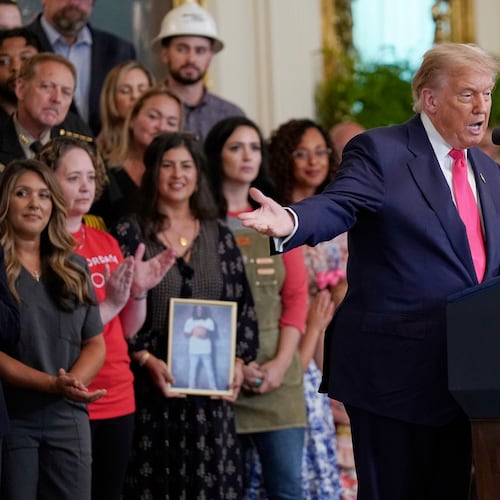State Rep. Stacey Abrams wears a lot hats.
She is leader of the House Democratic Caucus and directed a large and well-funded voter registration effort. She also runs several businesses and serves on a number of charitable boards.
She's even a romance novelist in her spare time. It's exhausting to contemplate.
One hat you might not know about is the one she wore as a paid consultant for Michelle Nunn’s failed U.S. Senate bid. You wouldn’t know it because the $30,000 she was paid was concealed behind a company with her sister’s name on it, and Abrams “forgot” to disclose it on legally required paperwork filed with the state.
In 2013, the Nunn campaign paid a Tucker-based company called Myrina Strategies $30,000 for political consulting. The company was registered to Abrams’ younger sister and Abrams name does not appear anywhere in the corporate paperwork or in the Nunn campaign’s campaign finance records.
Abrams claims there was no intent to deceive, but it is an astonishing misstep for a politician considered a rising star in the Democratic Party of Georgia.
The revelation of Abrams’ paid work for the Nunn campaign also adds to an emerging narrative that the bright young face of the Georgia Democrats is personally enriching herself off the political process, while spreading herself too thin to effectively serve her different constituencies.
Last month, The Atlanta Journal-Constitution reported Abrams earned $177,500 in 2014 as the CEO of the New Georgia Project, an arm of the non-profit Third Sector Development Abrams founded in 1998.
In 2014, the New Georgia Project set out to register tens of thousands of new voters in time for the mid-term election. The results were less than satisfying.
Of the 87,000 new voter registration submitted, only about half were on the rolls by election day and Secretary of State Brian Kemp launched an investigation into the organization after allegations of voter registration fraud.
Election law frowns on dual roles
Let’s be clear: If everything is as it has been explained, there is nothing illegal about Abrams working for the Nunn campaign.
Abrams was a vocal Nunn supporter and the two women have close ties. Abrams served on the board of the volunteer organization Hands on Atlanta, which Nunn ran for years, and Abrams said she considers Nunn to be a personal friend.
However, it was not clear that she was a paid staffer, nor could it have been. Not only was she paid behind a corporate veil, she also failed to disclose her interest in Myrina Strategies on her annual personal financial disclosure, a form required of people running for elected office in Georgia meant to reveal any possible business entanglements.
Abrams’ work for the Nunn campaign and her role as founder of the New Georgia Project poses one of those possible entanglements as they came very close to overlapping. Under federal campaign rules, The New Georgia Project cannot engage in partisan political activity on behalf of one candidate, so a reasonable person might consider Abrams’ dual roles fishy.
Jeff DiSantis, Nunn’s campaign manager, said it was clear that the New Georgia Project’s goals for 2014 were problematic for the Nunn campaign if Abrams were to remain on the campaign’s payroll, so the decision was made to end the paid relationship.
“In fairness to Stacey, she did agree. It was a mutual decision to end the relationship on Dec. 31, 2013,” he said.
‘I’ve never hidden my relationship’
Abrams said fire walls erected at The New Georgia Project would never have allowed her work with the Nunn campaign to come in conflict with the project’s voter registration efforts. But she said there was never an intention to hide her role with the Nunn campaign or her interest in Myrina Strategies.
“I’ve never hidden my relationship with the Nunn campaign,” she said. “If they had asked, I would have told them.”
Abrams said she and her sister set up Myrina Strategies to give her sister, a scientist, a platform to do some joint consulting projects, with Abrams providing her writing talents to complement her sister’s scientific output. But her sister quickly found full-time work and those projects never materialized, Abrams said.
When opportunity with the Nunn campaign came up, Abrams, a tax attorney by training, decided to use the corporation for that purpose. Myrina, an LLC, was the best “legal structure for contract work,” she said.
Abrams said it also allowed her to avoid “crossing the streams” with her other ventures, like the New Georgia Project and Sage Works, another consulting business she owns.
$5,000 a month
Gordon Giffin, former U.S. ambassador to Canada, chaired Nunn’s campaign and said Abrams provided “guidance and active involvement” in the early stages of the Nunn’s bid.
“She devoted a substantial amount of time to that effort and we felt it appropriate to compensate her for that time as a consultant to the campaign,” he said. “Her efforts permitted us to accelerate the development of campaign infrastructure as we undertook to gear up.”
The Nunn campaign says it paid Abrams $5,000 a month for her services with payments in September and early January. That’s six months work beginning in July and ending in December for a total of $30,000. Myrina Strategies’ corporate documents were filed in the Secretary of State’s office Sept. 3, 2013, meaning Myrina was incorporated well after Abrams began her work for the Nunn campaign.
The company was dissolved by the Secretary of State’s office last month for missing its annual corporate filing responsibilities. Abrams updated her 2013 personal financial disclosure to include her interest in Myrina. “It existed for a very short period of time,” she said. “I had honestly forgotten.”
Myrina Strategies may have made sense for Abrams the lawyer or Abrams the entrepreneur, but for Abrams the politician it was a serious stumble for a politician with such obvious ambition. The lack of corporate transparency combined with the near collision of her work with the New Georgia Project was too clever by half.
And it invites critics to wonder if she has at least one hat too many.
About the Author
Keep Reading
The Latest
Featured




